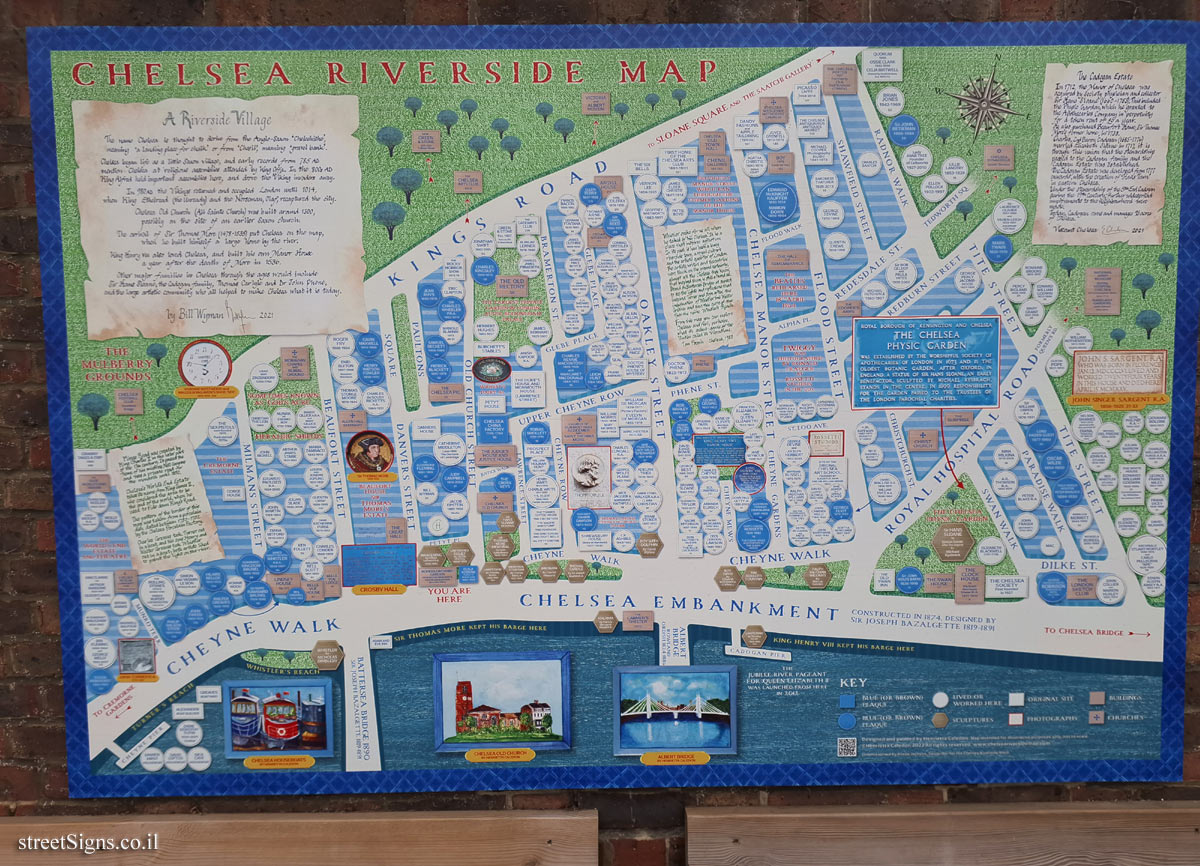CHELSEA RIVERSIDE MAP
A Riverside Village The name Chelsea is thought to derive from the Anglo-Saxon "Chelechithe, meaning ’a landing place for chalk or from "Chesil, meaning "gravel bank’.
Chelsea began life as a little Saxon village, and early records from 785 AD mention Chelsea at religious assemblies attended by King Offa. In the 800s AD King Alfred held important assemblies here, and drove the Viking invaders away.
In 980 Ad the Vikings returned and occupied London until 1014, when King Ethelread (the Unready) and the Norseman, Olaf, recaptured the city.
Chelsea Old Church (All Saints Church) was built around 1300, possibly on the site of an earlier Saxon church.
The arrival of Sir Thomas More (1478-1535) put Chelsea on the map, when he built himself a large home by the river.
King Henry VIII also loved Chelsea, and built his own Manor House a year after the death of More in 1536.
Other major Families in Chelsea through the ages would include Sir Hans Sloane, the Cadogan family, Thomas Carlyle and Dr John Phene, and the large artistic community who all helped to make Chelsea what it is today.
by Bill Wyman 2021
Kings Road was created by King Charles II in the later part of the 17th century. It passed the home of his Mistress Nell Gwynne and was a private road for the monarch until 1850.
Chelsea’s World’s End Estate takes its name from King James II, who considered the area to be the end of the world, when he used to ride down King’s Road.
The pattern of the border of this map was taken from a porcelain dish dated between 1750-1752 by the Chelsea Porcelain Factory.
Charles Greaves took Turner out in a boat and his sons Henry and Walter Greaves task Whistler out in a boat, both artists liked to paint the light on the river.
Whistler spoke for us all when he talked of my Chelsea. ’It is a place that inspires affection. In its past, it has been a busy riverside town, a royal suburb and the artist’s quarter of London. The artists writes and eccentrics were thick on the ground certainty, almost all the Chelsea they knew, that inspired them, is still around us. Strand on Battersea Bridge at sunset to see the lights and reflections that inspired Turner and soon after, the imagination of Whistler and Walter Greaves and gave this curve of the River the name Whistler’s Reach.
From this map you can explore Chelsea and feel, perhaps, what its avant-garde of the ’Sixties called its vibrations.
Tom Pocock
Chelsea , 1983
ROYAL BOROUGH OF KENSINGTON AND CHELSEA
THE CHELSEA PHYSIC GARDEN WAS ESTABLISHED BY THE WORSHIPFUL SOCIETY OF APOTHECARIES OF LONDON IN 1673 AND IS THE OLDEST BOTANIC GARDEN, AFTER OXFORD, IN ENGLAND. A STATUE OF SIR HANS SLOANE, AN EARLY BENEFACTOR, SCULPTED BY MICHAEL RYSBRACH, STANDS IN THE CENTRE. IN 1899 RESPONSIBILITY FOR THE GARDEN PASSED TO THE TRUSTEES OF THE LONDON PAROCHIAL CHARITIES.
The Cadogan Estate In 1712, the Manor of Chelsea was acquired by Society physician and collector Sir Hans Sloane (1660-1753). This included the Physic Garden, which he granted to the Apothecaries Company in perpetuity for for a token rent of £5 a year.
He also purchased Beaufort House, Sir Thomas More’s former home, in 1738.
Charles, 2nd Baron Cadogan (1685-1776) married Elizabeth Sloane in 1717, it is through this union that the stewardship passed to the Cadogan family and the Cadogan Estate Was Established.
The Cadogan Estate was developed from 1777 onwards, with the in creation of ’Hans Town’ in eastern Chelsea.
Under the stewardship of the 5th Earl Cadogan during the 19th Century, further widespread improvements to the neighborhood were made.
Today, Cadogan owns and manages 93 acres of Chelsea.
Viscount Chelsea
2021.


 Click for a larger image
Click for a larger image  Click for a larger image
Click for a larger image